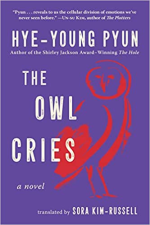When I run across reviews of interesting books that I think others might be interested in, I try to post links. Occasionally, I find something so compelling that I feel obligated to reproduce the review here if possible. And so the review of this book sounds so compelling and important that I do so now (I would especially note the second-to-last paragraph). From the
Asian Review of Books:
“Finger Bone” by Hiroki Takahashi
Finger Bone, Hiroki Takahashi, Takami Nieda (trans) (Honford Star, June 2023)
In his 1994 speech accepting the second Nobel Prize for Literature ever awarded to a Japanese author, Kenzaburo Oe claimed that, in the history of modern Japanese literature, “the writers most sincere and aware of their mission were those ‘post-war writers’” who “tried with great pains to make up for the inhuman atrocities committed by Japanese military forces in Asian countries.” He went on to describe more contemporary writers as “a youth politically uninvolved or disaffected, content to exist within a late adolescent or post adolescent subculture.”
Whether or not Oe’s characterization is fair, there are certainly few contemporary books about the Pacific War translated into English. That’s part of the reason Hiroki Takahashi’s
Finger Bone, translated by Takami Nieda, stands out as something fresh and different. Otohiko Kaga’s
Marshland, translated by Alfred Novick, is slated for release within the next six months or so and takes place in part during WWII. However, Kaga was a part of Oe’s own generation, published
Marshland in the 1980s, and died earlier this year. Nieda was born in 1979;
Finger Bone was published in Japanese in 2015.
Finger Bone begins in 1942 in Papua New Guinea. The unnamed, 21-year-old narrator is injured early in the novel. Most of the action takes place at Japanese Field Hospital No 3, where life is lived at a remove from the front lines. When a patient dies, medics remove a titular finger bone from the corpse and cremate it so they can return part of the soldier’s remains to his family. (The description is fairly graphic. As with many war novels,
Finger Bone may not be an ideal choice for squeamish readers.) Instead of chronicling military campaigns, the unnamed narrator describes his interactions with other injured soldiers recovering (or not) at the field hospital.
In part,
Finger Bone is a story about how little Japanese soldiers understood about the bigger picture during the Pacific War. Misinformation is rampant. An officer “blusters” about the Japanese army’s military successes, but, the narrator observes to himself, “Who knew if any of it was true”. In fact, “who knew if it was true” becomes a kind of refrain and one of the novel’s major motifs.
Throughout, the narrator and the other soldiers blithely assume the Japanese Imperial Army is winning. History will immortalize the man who kills General Douglas MacArthur. The native Kanak people will need to learn Japanese to accommodate the Japanese tourists who will visit the island at war’s end. There are air raids over the American coastal state of Oregon. The rest of the US mainland has been razed by firebombs.
The narrator never questions his assumptions in the face of his reality: all around him first his comrades and then his closest friends are slowly dying from lack of basic medicine and supplies. “Death,” he notes, has “become commonplace”.
The novel also asks the question, “What is war?” There are a few notable battle scenes, but most of the action is quiet suffering and oppressive waiting. The narrator describes a scene as unarmed, starving soldiers march down a dusty and empty road and reflects, “This is war… This too is war.” The words, he tells the reader, do not sink in.
Laudably, Takami Nieda’s translation gives no special quarter for Anglo-American readers. It’s always a jarring (and probably healthy) experience to read an account of familiar-looking soldiers as the Other. The enemy is a “young, pale-faced soldier” with blue eyes who “squak{s} something in English". She describes a Kanak living in New Guinea as "a black man", presumably translating the Japanese literally and ignoring English racializations. The overall effect is a book that presents a different point of view not just about the Pacific War, but about the way the world is organized--which is, presumably, a part of the reason people read translated literature in the first place.
Maybe Takahashi’s book doesn’t, as Oe once wished, “tr[y] with great pains to make up for the inhuman atrocities committed by Japanese military forces in Asian countries.” But it does address the futility of war, especially under governments that don’t give all the facts to their soldiers. Perhaps that was a timely reminder of what the Pacific War might have looked like to the men who fought in it. The novel debuted in Japan in 2015, while Japan’s politicians once again debated Article 9 of the Japanese Constitution, which “forever renounces war as a sovereign right of the nation”. Takahashi’s answer to the question “What is war?” seems to be, “Something that never makes sense.”
Alison Fincher (@FincherAlison) is a student of Japanese and an independent researcher of contemporary Japanese fiction. Read Japanese Literature is her podcast about Japanese literature and some of its best works.
